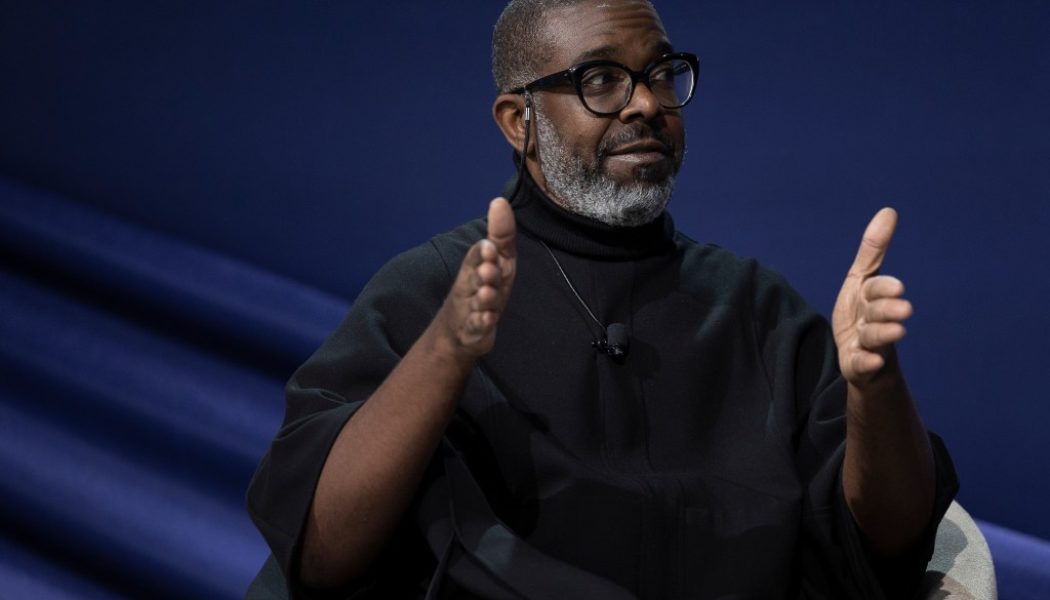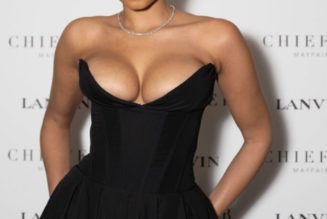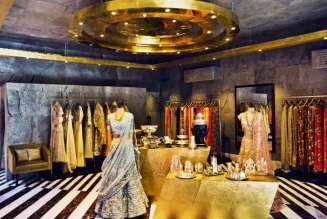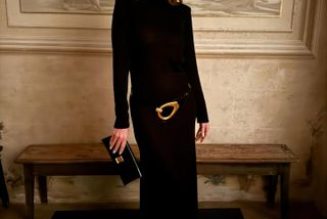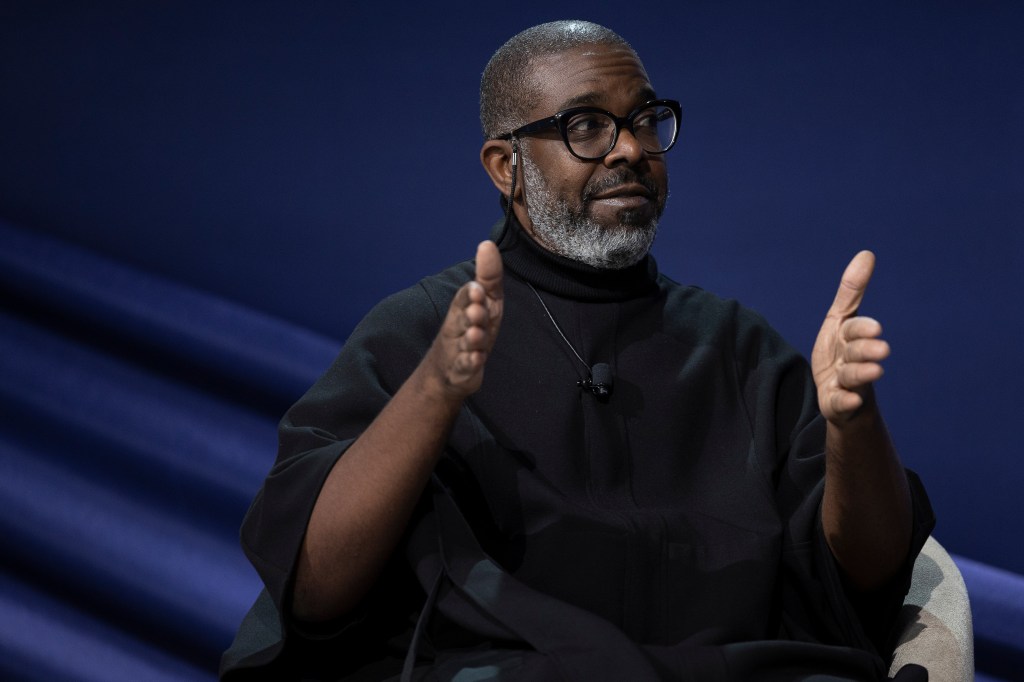
What constitutes a cultural brand, how luxury companies are faring and potential creative directorships were a few of the topics that A. Potts’ founder Aaron Potts discussed during a talk with Tara Donaldson, WWD’s executive editor and Fairchild Media Group’s head of diversity, equity and inclusion, at the Apparel & Retail CEO Summit.
After more than 20 years in the fashion industry, the New York-based designer has a good amount of perspective. The Detroit-born Potts has worked in the design rooms of multiple domestic and international companies. In 2018, he started his own company, A. Potts.
All in all, looking ahead, luxury needs to be redefined. He said, “For some people, luxury is what it is right now. But for new brands, and for people that are kind of on that cusp of sort of figuring out where they’re going, there is a sense of luxury embracing creativity. That’s been part of the issue with why American fashion has suffered. A lot of it has to do with the fact that we’ve decentered design. Then it becomes just about those sales books, and what sold and [a matter of] let’s repeat that,” Potts said. “Over the long run, that does a disservice to us, because we don’t have the time for creative innovation…there is this sort of spiritual and emotional quotient to what luxury can be. The people that are the most innovative on that front are touching on that.”
To start the Q&A, Potts spoke of what makes a cultural brand. Although the designer said that he tries to avoid having things like taglines, he understands why people have them. With more than 20 years of experience working on Seventh Avenue for such companies as Ellen Tracy and Badgley Mischka, he later spent some time in Germany at Escada. Potts described relocating from New York to Southern California and being laid off six months into his new role. While deciding what to do next, he took part in some self care time that included making some clothes for himself.
“It was a bit of therapy for me to help get over the hurt of being laid off — one of probably 2,000 people [who were]. One day I was in my closet, and I looked at the whole closet. The only clothes that I was wearing were the clothes right in the middle. Those clothes in the middle were the things that I had made for myself,” he said.
Their easy chic sensibility led to “a light bulb moment,” with the designer realizing that he had to make “those things that are in the middle of the closet for everybody.”
Having worked for other people “for so long,” Potts said he wanted to make a company that was about “real diversity at the base level — not just [the] models that you use, but really across the board.” As a start-up, he was able “to do that from the ground up,” pulling from people he had met over the years, including print designers, photographers, models and more.
Being able to choose them, Potts said his interest wasn’t just about talent, but also a shared “synergy that was based on a certain philosophy. A lot of that has to do with centering creativity, how we see ourselves in the bigger world and how we interact with one another leading from a place of love and understanding,” he said. “That was how I started my cultural brand.”
From Potts’ perspective, doing so is about the base level. ”If the company is only showing Black and brown faces on the runway, but the board room doesn’t look like that, if the design room doesn’t have transparency, if it doesn’t have people with disabilities, then it comes across like pandering. So for me, it’s a very natural expression. So it’s not something that I tried to do. It’s just something that I do.”
With more luxury companies presenting themselves as a cultural brand, or stating that they’re aspiring to that, Potts was asked to highlight what they’re getting right and where they might be missing something. He said, “It’s always great that people take a step back, and reevaluate, and see how they can do things better. I would just hope that it’s not just from a place of looking to capture a certain market and that it really comes from a place of really wanting to connect with people and put positivity into the world.”
What the incentive can’t be, according to Potts, is adhering to a trend, or an effort to gain new market share for a company. “It has to be really honest, and I think the consumer can actually feel that,” he said.
As for self-proclaimed cultural brand monikers, the designer was dubious. “If you call yourself a cultural brand, or a cool brand, those self-assigned monikers seem weird to me. I think that it is something that the community will call you. For me, it’s really less about calling yourself that and really doing the work [to show] what that means,” Potts said.
For companies, that comes down to more than who you feature in your ads, but whether on every level they really represent what they are saying. Explaining how he eschews labels of all kinds, the designer said, “Personally, I don’t like calling myself this or that. It’s kind of like, when I’ve heard people call themselves, ‘I’m a fashion icon.’ And I’m like, ‘Oh, don’t do that.’”
He contended that the companies “that do it the best” are the ones that invest in innovation, and invest in their design teams. “That’s really one way that people can show that they’re really invested in it. Otherwise, a lot of times, it’s easy to go through the motions. It doesn’t always connect, because it doesn’t feel real.”
For Potts, it is the human connection that motivates him. That applies to not just working with his design team, and other individuals who do jewelry, shoes, and other things he works with, but also customers.
“If people can express themselves creatively, express who they are, or who they discover themselves to be, when given the space to do that, they then can connect and be accepted. That’s it for me — how I can put something into the world that people can use in a way that benefits the world?”
As for his design approach regarding culture, Potts recalled when starting his label he made capes and oversized jumpsuits, before realizing they worked for every body shape. That is what made him center on a unisex sensibility that allows consumers to buy something and know the garment will still fit regardless if they gain 10 or 15 pounds as “normal people do.” They won’t have to get rid of their wardrobes, and can “still feel cool, chic, beautiful, or whatever it is that you need to feel,” Potts said, adding his goal is to design things that people will have to “fight themselves not to wear [again and again] because they’re useful and chic.”
Asked about his interest in taking on a creative director role with a luxury company to bring culture to it, Potts, not surprisingly, said he “absolutely” would be and that is something that he has given a lot of thought to. Having worked for a lot of big brands, and now having the responsibility and the joy of having his own line, the designer believes those experiences can feed each other. But “the biggest thing” would have to be if he and a company share similar values and the company would have a sense of compassion for him to do his own business, he said.
American designers could take a few cues from French and Italian luxury brands, which have been using culture in a way that has revolutionized how luxury brands communicate to their consumers, according to Potts. “French and Italian brands are the ones that are leading the conversations, in terms of centering creativity, and really investing in innovation and in talent. I’m a proud American, but I think, you know, American companies could take a cue from that.”
Addressing resources for cultural input, Potts recalled how his early years in fashion in the ‘90s was “a time when you could actually like, say racist things, you could say ableist things, and all of these things, and it does so much damage.” From his standpoint, part of the problem was that a lot of the people making the decisions “actually didn’t have any of those people in their lives. It’s one thing to have this sort of philosophical idea of like being together, we are the world and all of those things. But it’s something else, when you have a personal relationship with people who are different. That’s something I think we all can work on. That makes it somehow easier to understand people and understand where they’re coming from, if you have a personal relationship with someone who is like that. We can do a lot of different things in HR offices with different mandates and initiatives. But if they’re not done at a foundational level, it’s, it’s kind of like drag, you know?”
